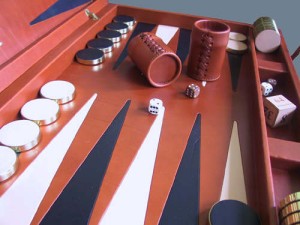Backgammon House Rules & Rule
Variants
 This
page on the Rules
of Backgammon contains all the rules for regular play, plus
the popular Acey-Deucey variant (which the following rules work
well with). It also defines the special terms used below (e.g. blot,
bearing off). Backgammon's a really old game that ultimately evolved
from the Egyptian game, Senet, which dates from at least 3100 B.C.
The version played today basically came about in the early 17th
century. Here, you can read about the History
of Backgammon. This
page on the Rules
of Backgammon contains all the rules for regular play, plus
the popular Acey-Deucey variant (which the following rules work
well with). It also defines the special terms used below (e.g. blot,
bearing off). Backgammon's a really old game that ultimately evolved
from the Egyptian game, Senet, which dates from at least 3100 B.C.
The version played today basically came about in the early 17th
century. Here, you can read about the History
of Backgammon.
Hits on Non-Blots. If doubles are rolled, or chosen on a
2-1 in Acey-Deucey, the current player may move multiple men onto
an opponent's line of men (even if it's not a blot) to hit them
(send them to the bar). This may only be done if the number of men
used is equal to or greater than the number of opponent's men being
hit and the current player's men used to hit are from the
same line.
Exact Numbers to Bear Off/No Inner Table Requirement. You
don't need all your men to reach the inner table before you can
begin bearing off. However, you can only make a man bear off if
you roll the lowest number possible to get him off the board. (E.g.
a man on line 2 requires a roll of 2 to bear off; a man on line
5 requires a 5; etc.)
Triple Die Gamble. On his turn, a player may elect to throw
three dice instead of two with the following consequence: if any
6's are rolled, he must send one of his own men (his choice) to
the bar for each 6 rolled, then end his turn. Doubles achieved with
a three-die roll still count, but there are no triples (e.g. the
current player rolls 4-4-4; he may move a number of men as if he
had rolled a 4-4 on two dice, then move a single man 4 lines). |
|
"Once the game is over, the King and the pawn go back in
the same box." — Italian Proverb
|
|